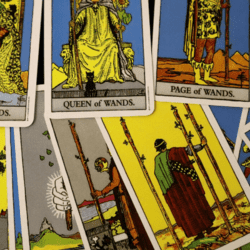
I see what amazing rituals do for people. People are able to connect to the deep, the numinous, the divine…they are able to connect to their deepest selves. They are able to transform, to build community, to draw down the gods, to re-energize themselves or focus their magic to a particular goal, they are able to heal. In the past weeks I’ve led a lot of rituals while I was on tour. I’ve witnessed people singing, smiling, connecting to that something beyond. I’ve witnessed people screaming, crying, releasing in catharsis. I’ve witnessed people drinking in the waters of the sacred well and refilling their hearts. I have seen over and over why ritual is important, and why good ritual is crucial.
Now–the word “good” is problematic because it implies a good/bad binary, and I’m not much of a supporter of dualism. So when I say good, what I mean is effective, potent. Ritual that achieves its intention. Ritual that takes us to a deeper place, ritual that successfully connects us to the gods or our deep selves or whatever the goal happens to be. So the first step to determining if a ritual is effective or not is to define the goals of the ritual. Simple seasonal celebration with social time? Or intensive catharsis with shadow work? Also, while I believe that personal/private rituals are also important, my focus here is on rituals for medium and large groups.
About a month ago my fellow bloggers John Halstead and Jason Mankey wrote a few posts back and forth about good/bad Pagan ritual. John’s post “Gods Save Us From Bad Pagan Rituals” was followed by Jason’s “Do Your Bad Pagan Ritual” and then countered by John’s “Lowered Expectations Are Not the Answer to Bad Pagan Rituals.”
And there may have been other posts but I missed them since I’ve been on the road for the past month. In fact, the reason I was on the road for a month is I was on tour leading rituals and teaching workshops on ritual facilitation techniques. So I’ve been wanting to write this post for a whole month!
Ritual is Worth Our Excellence
John’s first post was a little harsh, and though I do hear where he’s coming from, I was a bit taken aback by the tone. If you’ve read my articles or book on ritual facilitation, been to one of my classes, or attended one of my webinars (I run a group on Facebook for teaching ritual skills), you know I’m not shy about bringing up examples of rituals that sucked. However, I always offer the context too; these folks that led that ritual worked hard to make it happen, and I know that it’s not easy. Most people leading rituals have no training in performance or public speaking, and they may have extensive training in the theology of their tradition but not in the nuances of effective facilitation. Most “bad” rituals are what I’d call honest mistakes. While I do find it’s useful to bring up examples of facilitated ritual when teaching about the topic, I try to do so in a way that isn’t shaming.
For instance, I frequently bring up the example of Cakes and Ale for 100 that takes forever and people start having distracting side conversations, or purifying with sage for 60 that takes 45 minutes. The ritualists leading these rituals aren’t bad people, but they aren’t employing facilitation techniques that could make the ritual engaging, so the examples serve to educate.
Thus, there is some good advice in John’s post, I just don’t agree with the dismissive way he approached it.
I also, quite frankly, break a lot of the “rules” John lays out. However, it’s easier to break the rules once you know them, and I also have enough professional experience under my belt that I can get away with things that a newer facilitator couldn’t. For instance, I don’t really rehearse most of the rituals I do. Heck, I sometimes don’t even plan them til I start the ritual. But when I’m on a 3-week tour and I’m leading a workshop or a ritual every night, there’s no rehearsal time. Plus, I have no way of knowing 1. How many people I’ll have, 2. What kind of space we’ll have, and 3. How energized and engaged they’ll be, so I can’t really plan anything til I meet the group. I’ve led enough rituals that I can still make it work without much planning because I have basic ritual templates to pull from, and I also use an ecstatic, participatory, and extemporaneous style of ritual that adapts to each individual group. I’ve done dozens of different versions of the same ritual for the last 2 months I’ve been touring, and it’s different every time.
The point is, I can get away with things like that because I put in the time to learn the skills. I learned public speaking skills, facilitation skills, I learned to sing, and I learned to design/structure rituals. It takes work, time, and dedication, and our groups are worth it, our communities are worth it. Ritual is worth our excellence.
Is Bad Ritual Ok?
Jason Mankey’s post, “Do Your Bad Pagan Ritual,” makes a number of points I disagree with. One point I can solidly get behind though: Do your ritual even if it’s not great. Here’s something that I teach in my classes on ritual: Do it, step in and do it even if you aren’t an amazing facilitator. Because, you’ll never have a chance to learn and get better if you don’t try it. I meet so many people that are petrified of screwing something up by taking on a ritual role, they’re afraid to say the wrong thing or mess up. Maybe you’re afraid of public ridicule, maybe you’re afraid of offending the gods.
The point here is that anyone who has led a ritual has screwed something up.
I had the benefit of going through an apprenticeship process where emerging leaders were given small ritual roles, then larger ones. Even if we borked up a role, it didn’t derail the whole ritual because with a staff of 10-20 other strong leaders, the container was still strong. The best thing I ever did, as someone petrified of public speaking, was to completely screw up a ritual role, and then realize the earth didn’t swallow me up, I didn’t die, I wasn’t shamed, and I could dive back in and try it again the next night at day two of the weekend intensive. So, when people see me leading a ritual now, they’re not seeing the early years and the screw ups. For that matter, I still screw things up, I’m just better at making it look like that’s how it was supposed to go.
So yes–do the ritual, even if it’s not great. I know not everyone has the benefit of that kind of apprenticeship process, but go ahead and do it anyways. You’ll learn and you’ll get better.
At least–as long as you’re willing to learn from what you did and work to improve.
Where I most disagree with Jason’s post is in the idea that public ritual (or semi-public ritual, like at a festival) can’t be transcendent. I do deep, intense rituals that bring on catharsis, transcendence, divine communion, and other hallmarks of a transformative experience. And I do them all the time as public rituals or festival rituals.
It’s absolutely possible to do work like that at a public ritual, there are just spectrums of what you can actually achieve based on a number of factors. If you come to my Pagan Pride Day ritual expecting the same intense experience you got at a three-day retreat, you’re going to be disappointed.
I often say that the most difficult rituals I lead are Pagan Pride rituals. This is because I’m typically hired to come into town, so I haven’t seen the space, usually the ritual space is in an open field in 95 degree heat with the sun overhead and no tree cover for shade or acoustics…I don’t know the group at all or how many people I can engage to take on ritual roles, I don’t know how many people we’ll have attending or whether or not they’ll be willing to sing…and there’s the circle of people attending the ritual, the outer circle of Pagans just sort of watching, and then the further cluster of non Pagans watching and going, “WTF is this…” so we’re also fishbowled/on display. Oh yeah, and I can’t build a fire in the middle either.
And yet, even when I do rituals in spaces like that, I consistently hear, “I’ve never been to a ritual before where I actually felt the gods, and I’ve been Pagan for 20 years!”
That right there is why I have devoted a good portion of my life to teaching effective ritual facilitation techniques. When people tell me that I weep, I really do. I’m so sorry that they never had that experience. One of the causes (not the only one) is that they were attending poorly-led rituals.
So yeah–it’s true that it’s harder for me to get a group to go deeper at something like a Pagan Pride, I can still successfully get a group to some depth. If I am leading a public ritual in a place where I have some control over the space (good acoustics, ability to light candles and use a cauldron fire, and a door that locks for privacy) I can take the group into more depth.
Initiations, Mysteries, and Rituals That Go Deeper
When people (often folks with a background in Wicca) refer to initiated mysteries, here’s how I translate that for non-Wiccans. Initiation, at the core, means you’ve been through it. You’ve been through the heat of the forge fire and been transformed. You’ve drunk the waters of the Grail and changed. Lots of things can initiate us that have nothing to do with Paganism and everything to do with the rituals of life. There are the standard ones–giving birth, getting married, having sex, but there’s also the first time you experience the death of someone you care about. There’s the time that you get teased, and bullied, and you survive it and keep going. There’s the first time you really seriously injure yourself, there’s the time you get a dangerous medical diagnosis. There’s the time you almost die in a car accident. There’s the time you realize your partner is abusing you. There’s the time that someone tells you that what you said to them really mattered, that you made a difference in their lives. There’s the time someone tells you that you’re beautiful.
That list can go on, but all of those are potential initiations. They are transformations. You are not who you were. You have gone through an experience that has shaped you.
Ritual initiations seek to do the same thing, but on a more spiritual/intentional level. They seek to connect you to the deeper mysteries. And when I say mysteries, what I mean is, things I can’t explain to you. (Yes, this makes it hard to write about them.) The essence is, I can tell you all about my initiatory ritual at Diana’s Grove. I can explain it in a descriptive way, enact it through interpretive dance. But it wasn’t a ritual for you, and I can’t transmit the experiences I had and the emotions they evoked.
I can tell you how they had me sit while members of our community laid white roses at my feet while they told me (personally and vulnerably) what I meant to them and how much they loved me. I can tell you how we were drawn forth to walk through a gauntlet of people, each holding a candle in the darkness, each looking into our eyes and telling us, “I believe in you Shauna,” and then, “Don’t let us down, Shauna.” I can explain all of that to you, and much more–but it doesn’t get across the shiver across my spine. The tears welling in my eyes. The thoughts and feelings I was experiencing.
I can explain to you the moments I’ve touched the divine, but that doesn’t mean you’ve touched the divine because I explained it.
What this means for public vs. private ritual is simply this: Yes, I can take a group fairly deep in a public ritual if they’re at all willing to go there. And, if I only have a short amount of time, that lessens the depth we can engage in. I’ve done some Pagan Pride rituals that were only 20-40 minutes, which is barely enough time to get people into a basic sense of comfort with one another. Sometimes I can engage a trance state in the group in that time, but if I have an hour and a half or more I can get the group into far more depth. Extend that further to a daylong intensive with a ritual that evening, or a three-day weekend intensive. Or a weeklong event with rituals each evening that build upon each other.
Time, Depth, and Intimacy
Sometimes it’s not necessarily about whether or not you’re initiated into a tradition, it’s just about time/connection. Rituals after spending a day with a group, or a weekend, have far greater intensity because there’s more group intimacy, more connection. There’s more reason to energetically engage when you know the other people there. Thus, I can take a group to a pretty deep place at a Pagan Pride ritual or other public ritual, but I can take them far deeper in context of a longer intensive.
In my own experience, I can get a certain amount of catharsis in a group ritual with 50-100 people I don’t know. But, when I’m in a group ritual and there are people there that know my baggage, know my pain, know my experiences…when I feel truly safe displaying an emotion with those people, I’ll be more comfortable expressing those emotions. And if I’m with a group of people and we’re doing something together that really matters, that too adds energy and intensity. For instance, when I worked with an ADF grove on a ritual to basically juice-up/re-energize their Grove in an annual ritual they engage in for that purpose, we had two things going for us. It was a weekend retreat with cabins so we had time and privacy, and, everyone knew each other and was committed to their Grove.
Thus, yes–it’s true that some types of public rituals are, by their nature, not going to have some of the basic components that help to make a more potent experience, but there are things you can do as a leader of public rituals to make them better.
Making Rituals Better
I can go on about specific techniques, but that’s why I’ve got a book on the topic and more on the way. And frankly, some of the ritual techniques I use, I can’t teach through books or even through the webinars I offer. They have to be experienced and experimented with, they have to be tried out in person. Here are a few quick tips, and if you’re looking for more specific assistance on how to do any of these, comment or message me and I’ll do my best to connect you to resources.
Improve your public speaking. Get rid of scripts (memorize the script, or do extemporaneous ritual, but get those scripts out of your hands). Work with the space you have; move the ritual from the sunlit field by the loud soccer game over to that nice shady spot under the trees with better acoustics. Design the ritual to engage a trance state. Learn how to engage a trance state in your group. Learn how to design an effective ritual for your specific purpose, for your specific group, and for the space you’re in. Make sure your logistics (like Cakes and Ale, saging/purifying, taking a bead from a bowl, people visiting a deity to hear wisdom, or any other time you have people doing a thing) don’t turn into a train wreck where people are standing their waiting for their turn, burning in the sun, bored as heck.
Pro tip: in almost any ritual, boredom is not an effective technique to help people connect to the divine. (Unless you’re in a sensory deprivation tank, then it’s intentional and can work.)
In essence, ritual facilitation is a professional skill set. If you learn the skills to make it work, and work to train others on your team to do the same, you rituals will get better. And, as Jason mentions in his article, sometimes amazing ritualists still present a turd sandwich. Happens to me too. But if you build your skills, you’ll have a lot less sandwiches of that particular variety, and you’ll have a lot more people that are finally able to connect to that something else that they’ve been seeking their whole lives.

Patheos Pagan on Facebook.

the Agora on Facebook
Seeking the Grail is published on monthly on the third Monday. Subscribe via RSS or e-mail!
Please use the links to the right to keep on top of activities here on the Agora as well as across the entire Patheos Pagan channel.













